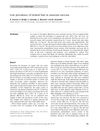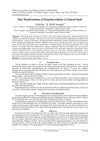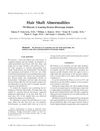Search
for
Sort by
Research
60-90 / 1000+ resultsresearch Pili Torti: A Feature of Numerous Congenital and Acquired Conditions
Pili torti is a rare condition where hair is twisted and breaks easily, often linked to genetic disorders or other health issues.

research Yellow Hair Following Sequential Application of Bacitracin Zinc and Selenium Sulfide: Report of Acquired Xanthotrichosis and Review of Yellow Hair Discoloration
Using bacitracin zinc and selenium sulfide one after the other can temporarily turn white hair yellow.

research Hairy Pinnae After Orchiectomy and Chemotherapy for Testicular Cancer: Acquired Localized Hypertrichosis of the Ears
A patient grew extra hair on their ears after treatment for testicular cancer, possibly due to hormonal changes or genetics.
research Use of Valproic Acid for the Treatment of Neuropsychiatric Symptoms in Acquired Brain Injuries
Valproic acid effectively reduces aggressive and impulsive behaviors in brain injury patients with acceptable side effects.

research Hereditary, Congenital, and Acquired Alopecias
Different types of hair loss in dogs and cats have various causes and treatments, with outcomes ranging from good to uncertain.
research Increased Scalp Skin and Serum 5 Alpha-Reductase Reduced Androgens in a Man Relevant to the Acquired Progressive Kinky Hair Disorder and Developing Androgenetic Alopecia

research Hereditary, Congenital, And Acquired Alopecias
Alopecia in animals can be hereditary, congenital, or acquired, with treatments and outcomes varying widely.
research The Developmental and Molecular Requirements for Ensuring That Human Pluripotent Stem Cell-Derived Hair Follicle Bulge Stem Cells Have Acquired Competence for Hair Follicle Generation Following Transplantation
Scientists found the best time to transplant human stem cells for hair growth is between days 16-18 when they have the right markers and growth potential.

research Unruly Hair
The document concludes that unruly hair can be congenital or acquired, often lacks specific treatments, and can be managed with oils and short hairstyles.

research Acquired Alopecia
Acquired alopecia is hair loss that can be reversible or irreversible, depending on whether the hair follicle is destroyed.

research Hair Shaft Dysplasias
Hair shaft dysplasias are abnormal hair conditions that can be inherited or acquired and may signal other health issues, with limited treatment options available.
research Poliosis Circumscripta: Overview And Underlying Causes
Poliosis circumscripta is a patch of white hair caused by lack of melanin, linked to genetic and acquired conditions.

research Dissociative Disorders in Childhood Sexual Abuse Victims
Passiflora incarnata may help with anxiety but has risks and drug interactions.
There's a genetic link between Fragile X Syndrome and Autism Spectrum Disorder.
6.7% of urine cultures showed hospital-acquired urinary tract infections.
Children used screens more during COVID-19, causing various health complaints.
Autism Spectrum Disorder is often underdiagnosed in females.
Dissociative disorders in childhood sexual abuse victims are more common in males.
Most pregnant teenagers are not dissatisfied with their body image but worry about weight.
Diagnosing tuberculosis after knee surgery is challenging due to non-specific symptoms.
Post-COVID-19 syndrome is more common in older, severely affected patients.
Psychiatrists should be part of pain management teams due to the psychological aspects of pain.
research Hypertrichosis
The document explains the types of excessive hair growth and how to manage it.
research Low Serum Biotinidase Activity in Children with Valproic Acid Monotherapy
Children taking higher doses of valproic acid had lower biotinidase activity, which may lead to biotin deficiency, but biotin supplements could help.

research A Current Review of the Cutaneous Manifestations of Renal Disease
Skin problems are very common in people with end-stage kidney disease.
research Congenital Generalized Hypertrichosis: The Skin as a Clue to Complex Malformation Syndromes
Excessive body hair can signal complex health issues.

research Malignancy and Cancer Treatment-Related Hair and Nail Changes
Hair and nail changes can indicate health issues, including cancer and side effects from cancer treatments.

research Clinical and Laboratory Evaluation of AIDS Trichopathy
People with HIV and low T cell counts have more hair and scalp problems.

research Office Diagnosis of Hair Shaft Defects
The document explains how to identify different hair problems using a microscope.

research Black Women's Hair: The Main Scalp Dermatoses and Aesthetic Practices in Women of African Ethnicity
Black women's unique hair characteristics and styling practices can lead to specific scalp conditions, which require early diagnosis and appropriate treatment.

research Ethnic Hair Disorders: Diagnosis and Management
Understanding and treating hair disorders in different ethnic groups requires knowledge of specific hair care practices and hair characteristics.

research Cutaneous Changes in Patients with Chronic Renal Failure on Hemodialysis
Patients with chronic renal failure on hemodialysis often have skin problems like dry skin, itching, and nail changes.

research Low Prevalence of Twisted Hair in Anorexia Nervosa
Twisted hair is rare in severe anorexia nervosa, found in only 2 out of 30 patients.

research Ptosis in Childhood: Causes, Clinical Presentations, and Management
Childhood ptosis can vary from a minor cosmetic issue to a serious condition and may signal other health problems.
research Genes and Immune Response in Alopecia Areata: Review of the Alopecia Areata Research Summit First Day Proceedings
Alopecia areata involves complex immune and genetic factors, with potential treatment targets identified, but more research is needed.

research Skin Manifestations of Hypothyroidism: A Clinical Study
Most people with hypothyroidism have skin problems like dry skin and hair loss.

research The Spectrum of Nephrocutaneous Diseases and Associations
Skin doctors should know about skin and kidney disease links to prevent serious kidney problems.

research Hair Shaft Abnormalities: Pili Bifurcati - A Scanning Electron Microscopy Analysis
The study found that pili bifurcati causes hair to intermittently split into two branches, each with its own outer layer.